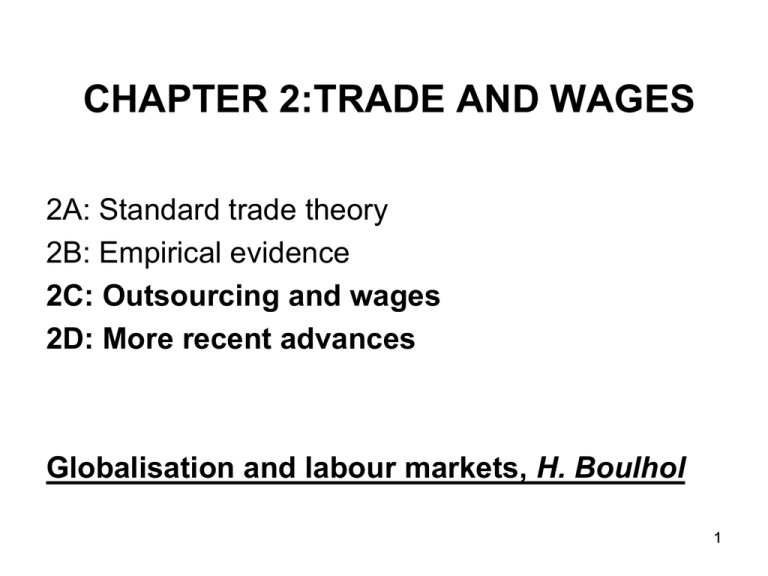CHAPTER 2:TRADE AND WAGES
advertisement

CHAPTER 2:TRADE AND WAGES 2A: Standard trade theory 2B: Empirical evidence 2C: Outsourcing and wages 2D: More recent advances Globalisation and labour markets, H. Boulhol 1 2C: Great unbundlings (Baldwin) • International integration has reduced the importance of geographic proximity between: - consumers and producers (unbundling type I) - suppliers of intermediates and final good producers (unbundling type II) • Relocations of production across distance and borders are easiers • More specialisation in production 2C: Great unbundlings (continued) Globalisation might imply that changes in the labour markets are not monotonously related to education or skills, but rather to the extent to which activities can be unbundled That is, globalisation might be consistent with the polarisation discussed in 2B See trade in tasks (Paper 3: Grossman and RossiHansberg, 2008) 2C: Trade in intermediates (Feenstra, chapter 4) • Trade in intermediate inputs (combined with international capital mobility) can affect production and factor prices very differently than trade in final goods • How? As intermediates are used across industries, a change in the price of intermediate inputs has an effect within industries: trade affect labour demand within industries 2C: Semantics • Phenomenon - geographical separation of activities involved in producing a good across several countries - Improved communication and lower tariffs have allowed firms to fragment their operation, moving less-skilled labour intensive stages of production to countries where low-skilled wages are low (transfer of production) • Terminology Trade in intermediate inputs / outsourcing / delocalisation / fragmentation/ vertical specialisation / slicing the value chain / production sharing / offshoring 2C: Feenstra and Hanson (1996, 2003) • Structure of the model: 2 intermediates y1 low-skilled intensive y2 high-skilled intensive Continuum of final goods (bundles of y1 x y2) each industry combines activities of various factor intensities Context: USA / Mexico trade + maquiladoras Trade with Mexico is associated with a fall in p1/p2 2C: Outsourcing in Feenstra & Hanson • Accumulation in South generates: - Fall in low-skilled intensive imported intermediate input prices in North - Decrease in the relative wage of low-skilled labour - Increase in demand for and in the relative wage of skilled-labour in both countries TRADE CAN WORSEN THOSE THAT ARE THE LEAST WELL OFF IN A POOR COUNTRY Effects are similar to SBTC 2C: Outsourcing (continued) • Intuition of the mechanism at work: - goods at the boundary of those produced in the USA and Mexico are the most skilled incentives goods in Mexico and simultaneously the least skilled incentive ones in the USA - at the margin, expansion of outsourcing displaces activities that are the least skilled intensive in the USA and the most skilled incentives ones in Mexico 2C: Outsourcing (end) • Empirical analysis: - outsourcing has an impact on inequality of a similar order of magnitude than the development of computers (proxy for SBTC), - but results are sensitive to how computer use is measured (share of capital stock vs share of new investment) 2D: More recent advances • Yeaple (2005) • Milanovic and Squire (2005) • Egger and Kreickemeier (2008) 2D: Yeaple (2005) • Starting points: - not all firms participate in export markets - exporters tend to be larger, use more advanced technologies and pay higher wages - exporters tend to be more productive 2D: Yeaple (continued) • Insight - firms are intrinsically homogenous - heterogenity of workers combined with competing technologies, international trade costs give rise to firm heterogeneity • Setting - 2 different technologies co-exist with different unit cost; low unit cost (i.e. newer) technology requires fixed cost - skilled workers have absolute advantge in both, but comparative advantage in the low unit cost technology - trade costs: fixed cost + iceberg transport cost 2D: Yeaple (end) • Mechanisms - Given the fixed cost of trade, only firms that use the low unit cost technolgy enter the export market, thereby selling large quantity Firms endogenously choose to employ different technologies and hire different type of workers • Implications - Exporters are larger, use more advanced techn., pay higher wages Reduction in transport cost increases the incentive for firms to adopt the newer technology Skilled workers are reallocated from the old technology to the new Low-skilled workers leave the industry for employment elsewhere Trade between identical countries raises relative demand for skilled workers 2D: Milanovic and Squire • Objectives - New empirical investigation of the relationship between globalisation and inequality - What happens to countries non participating in globalisation? - Does globalisation affect countries that do not change their trade policies? 2D: Milanovic and Squire (continued) • Findings - Global expansion of trade reduces the export volumes or prices of non-globalising countries - In addition to non participating in the benefits of globalisation, non-globalising countries see a deterioration in their positions compared with preglobalisation era - Liberalisation efforts between other countries matter - Relative trade liberalisation is important 2D: Egger and Kreickemeier (2008) • Starting points - Increase in inequality within groups account for 2/3 of increase in total inequality - Increase in within group inequality seems to be related with increase in intermediate goods trade • Features - Inequality along 3 dimensions: between groups (entrepreneurs vs wokers) and within groups (entrepreneurs and workers) - Firm heterogeneity results from heterogeneous abilities of entrepreneurs - Fair wage-effort • Main results: TRADE INCREASES INEQUALITY, IN ALL DIMENSIONS, AND AGGREGATE UNEMPLOYMENT










